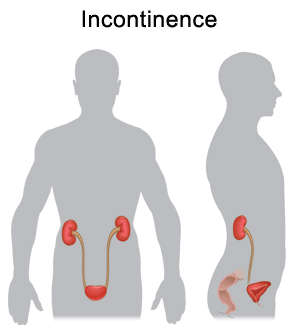Medical Library
Pick a Body Area
Incontinence

Incontinence is the loss of bladder or bowel control, resulting in involuntary leakage of urine or feces.
Pelvic floor muscle weakness, resulting in a reduction of muscular support for the bladder, uterus or rectum, may be the cause. The muscles, because of disuse, are unable to tighten and keep the openings closed.
Incontinence of urine may be termed:
- Stress (leakage with physical activity, coughing, sneezing or laughing)
- Urgency or Frequency (involuntary bladder emptying whenever the sensation of urge is felt)
Involuntary leakage of feces and gas can be the result of chronic constipation or trauma.
Behavioral assessment of food, beverage and medication consumption can identify contributing factors.
Treatment often includes:
- Retraining bowel and bladder habits.
- Abdominal muscle rehabilitation.
- Pelvic floor muscle rehabilitation (with or without electrical stimulation).
- Biofeedback.
Possible Treatments
Possible Treatment Goals
- Improve Function
- Improve Muscle Strength and Power
- Improve Proprioception
- Improve Relaxation
- Self-care of Symptoms
- Improve Tolerance for Prolonged Activities
Additional Resources
Disclaimer
The information in this medical library is intended for informational and educational purposes only and in no way should be taken to be the provision or practice of physical therapy, medical, or professional healthcare advice or services. The information should not be considered complete or exhaustive and should not be used for diagnostic or treatment purposes without first consulting with your physical therapist, occupational therapist, physician or other healthcare provider. The owners of this website accept no responsibility for the misuse of information contained within this website.
